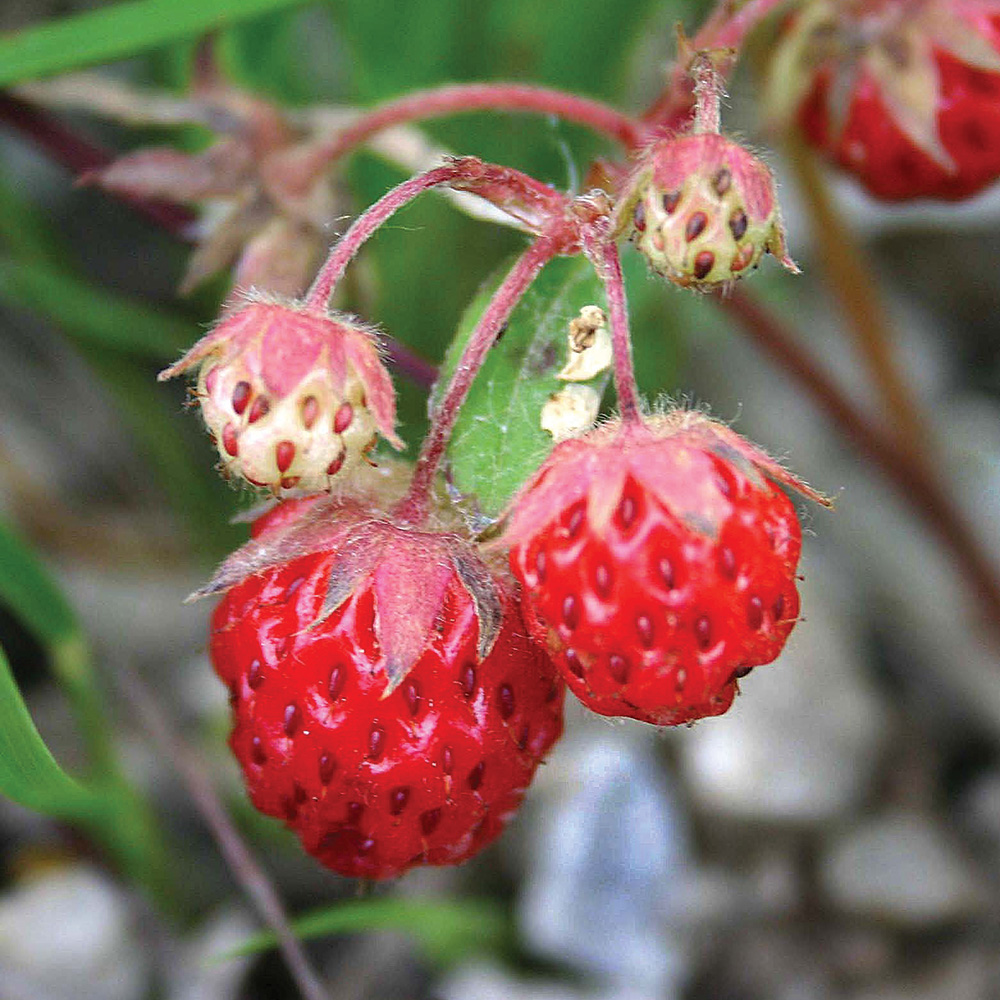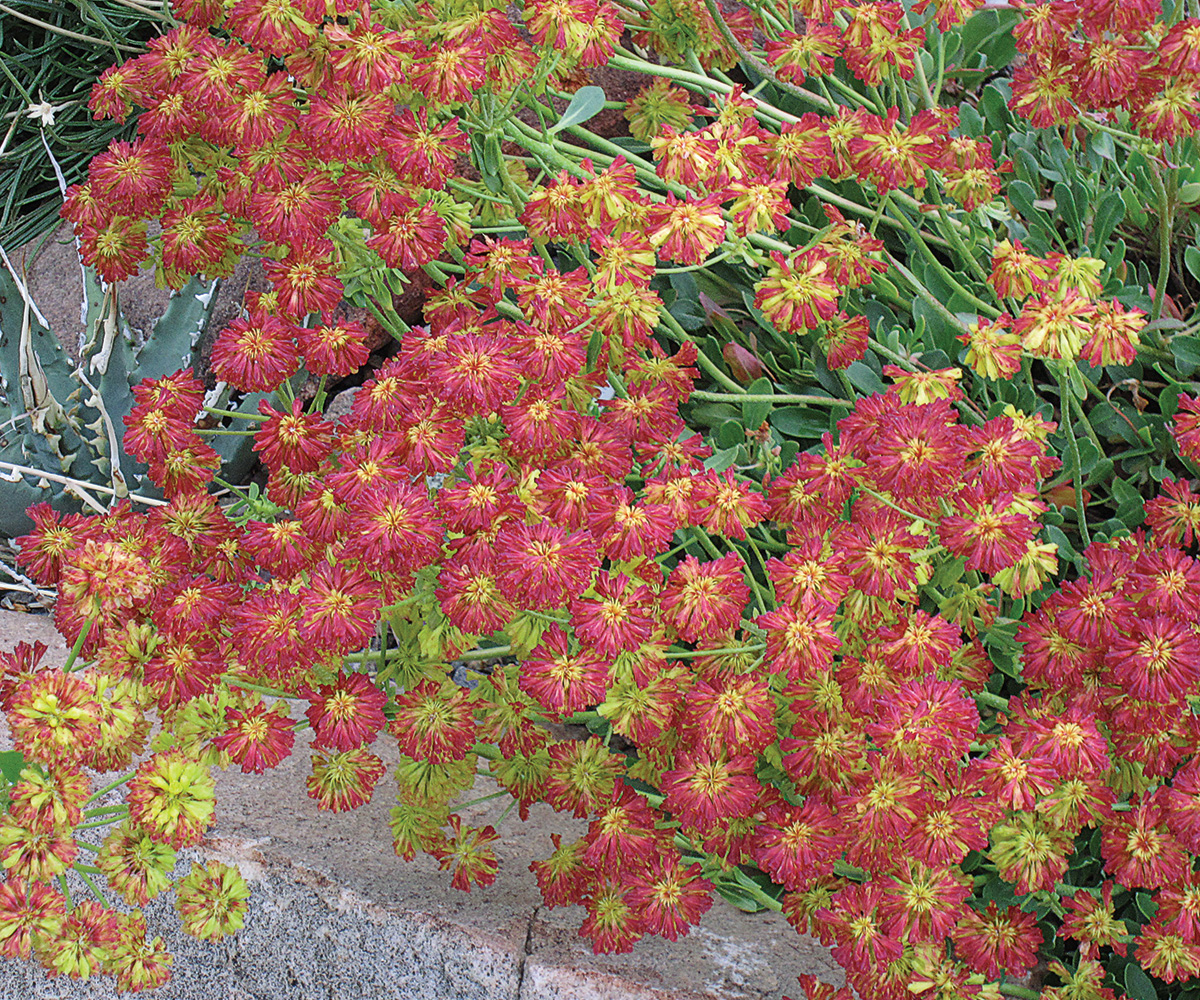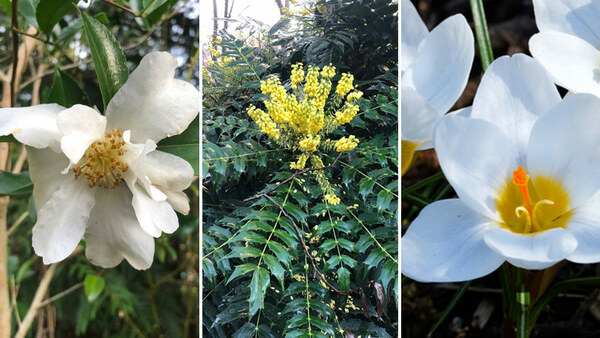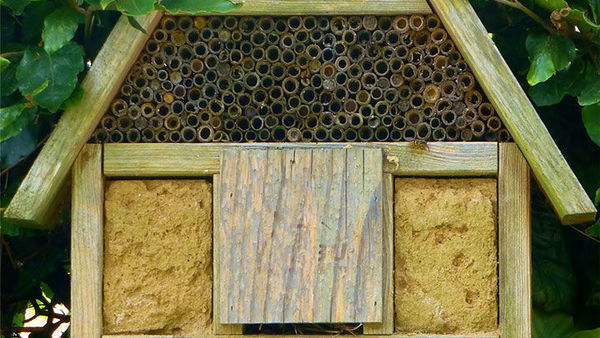
Although pollinator populations are diminishing worldwide due to habitat loss, climate change, pesticides, and disease, gardeners can slow this decline through cultivating and maintaining safe environments where winged garden visitors can find sustenance and take shelter. Combining well-chosen trees, shrubs, perennials, and vines to create a varied habitat will attract and support a broad range of bird, mammal, and insect species. Incorporating a strategic array of ground covers into this mix is a great way to maximize the wildlife benefits your garden offers.
Lawns are green deserts for wildlife, and areas that are mulched with bark, pine needles, or gravel offer little habitat and no food for beneficial insects and other creatures. In the wild, bare soil hardly exists; it is always covered with plants. Then why do we leave so much exposed soil in our gardens? Most gardens offer many opportunities to layer ground covers beneath and between perennials, shrubs, and trees, adding beauty and multiseason interest. Look for nooks and crannies in pathways, along border edges, in walls, and along stairways where pockets of bare soil could be filled with ground covers. Trailers that drape over the edges of hardscaping and container plantings add fun, whimsy, and a sense of completeness to your designs. Add the right ground covers and the pollinators will thank you.
Don’t stop at ground covers!Learn how to install and care for a complete pollinator haven. |
Choose the best ground covers for your garden
With thousands of ground covers to choose from, which ones will be best for your pollinators? One helpful strategy is to select ground covers that offer a succession of blooms from early spring until fall. While some pollinators are active through much of the growing season, others may live for just a few weeks. Including long-blooming varieties ensures that there will be a bounty of nectar and pollen from the time the snow melts in spring to when your garden freezes again the following winter. It is best to select plants that have flowers with a diverse array of sizes, shapes, and colors. Each pollinator species seeks out particular bloom sizes and shapes. For example, hummingbirds appreciate large, tubular flowers, while butterflies need smaller tubular flowers and a place to rest while feeding. Native bees of various sizes also need a range of flower types from which to feed. The greater the diversity of flower shapes, sizes, and colors, the more pollinators you will attract.
It is also ecologically beneficial to choose ground covers with a variety of foliage textures and with different growth habits, including rhizomatous, suckering, stoloniferous, spreading, and trailing. Covering the ground with diverse plantings will support insects that are food sources for songbirds, frogs, toads, snakes, and mammals. It will also encourage a richer biome of healthy soil bacteria and fungi that support overall plant health.
Including native plants is a guaranteed way to attract and support local pollinators that have co-evolved with these species and that seek out the protein and fats provided by pollen and the sugary nectar they need for energy. Native plants are also often the only larval hosts for native butterfly and moth species. However, since not all our natives have long bloom periods, and since our small gardens can’t compensate for the loss of natural habitat to urban and agricultural development, nonnative plants can be used to fill gaps in nectar and pollen supply. The following are some of the many fine ground covers that you can incorporate into garden designs to add beauty and provide the greatest pollinator benefits per square foot.
Spring Flowers Sustain Emerging Pollinators
Virginia strawberry spreads sweetly around taller plants


Name: Fragaria virginiana
Zones: 3–9
Size: 3 to 9 inches tall and 12 to 24 inches wide
Conditions: Full sun to partial shade; rich to average, well-drained soil
Native range: North America
Pollinator power: Attracts a variety of native bees and hoverflies; nectar source and larval host for dozens of butterfly and moth species
This tough, vigorous, easy-to-grow ground cover is also a powerhouse for pollinators. The white, five-petaled flowers provide nectar and pollen for early foragers from spring to early summer, and the small, tasty fruits that follow will delight chipmunks, squirrels, birds, and humans alike from early to midsummer. Use it under and around taller plants, as a lawn substitute, or as a slope stabilizer. In good conditions it will spread almost indefinitely. While the plants grow and spread quickly, it may take time for the rosettes to provide a closed cover. Virginia strawberry will tolerate occasional foot traffic and is deer- and rabbit-resistant. The plants appreciate evenly moist soil but will tolerate short periods of drought.
Rock soapwort is a small, fragrant powerhouse

Name: Saponaria ocymoides
Zones: 3–8
Size: 4 to 8 inches tall and 12 to 24 inches wide
Conditions: Full sun; average to dry, well-drained soil
Native range: Sunny slopes and rocky areas from Spain into the Alps
Pollinator power: Attracts bees, butterflies, and possibly hummingbirds
Here is an extremely hardy, old-fashioned perennial that forms compact carpets of vigorous, semi-evergreen foliage. In late spring and summer, the densely branched plants are topped with prolific clusters of small, fragrant flowers that can be bright pink to white, depending on the cultivar. Plant it in average to poor soil with good winter drainage; you will find that it is quite tolerant of drought. It is perfect for small to medium-size areas in rock gardens, between stepping stones, along pathways, on slopes, and atop walls. Rock soapwort is deer resistant and tolerates occasional foot traffic.
Roundleaf groundsel furnishes pollen, nectar, and spring cheer

Name: Packera obovata
Zones: 3–8
Size: 12 to 20 inches tall and 6 to 12 inches wide
Conditions: Full sun to partial shade; dry to wet soil
Native range: Eastern North America
Pollinator power: Attracts many species of native bees, hoverflies, and beetles; larval host to the northern metalmark butterfly
Roundleaf groundsel greets spring with cheerful yellow flowers that seem to float above mats of basal foliage. It is adaptable to a variety of sun and soil conditions, making it useful for repeated plantings that visually connect different areas of the garden. Its flexibility and quick growth rate make it an ideal candidate anywhere a tough, easy-to-grow, weed-suppressing ground cover is needed. It spreads by both stolons and rhizomes to form dense mats of rounded, semi-evergreen leaves that are 4 to 6 inches tall. The flat-topped clusters of golden yellow, daisylike flowers rise on nearly leafless stems that are 10 to 20 inches tall. Plant roundleaf groundsel en masse under trees and large shrubs, beside water features, along pathways, in borders, in woodlands, and on slopes for erosion control. It is deer resistant.
Peak-Season Flowers Offer a Fresh Bounty for Winged Visitors
‘Honey Coral’ trumpet honeysuckle tempts hummingbirds, butterflies, and bees

Name: Lonicera sempervirens ‘Honey Coral’
Zones: 4–9
Size: 8 to 24 inches tall and 10 to 15 feet wide (without support)
Conditions: Full sun to partial shade; rich, moist, well-drained soil
Native range: Eastern North America
Pollinator power: Attracts hummingbirds, butterflies, and bees; larval host for several moth and butterfly species
Trumpet honeysuckle is a native vine beloved for its bright red but sometimes yellow flowers that bloom in mid to late spring and intermittently throughout summer. ‘Honey Coral’ is a valuable compact form of the species. Though this vigorous, twining vine can grow 10 to 15 feet tall or more if it is trellised, in the absence of vertical structures it can perform well as a large, rambling ground cover. Use it on slopes and banks or to cover open areas, uneven ground, and unsightly landscape features such as rocks or stumps. Its tube-shaped flowers are appealing to many pollinators, and its red berries are attractive to birds in autumn. ‘Honey Coral’ is tolerant of drought and resistant to deer and rabbits.
‘Poncha Pass Red’ sulphur buckwheat is colorful over a long season
Name: Eriogonum umbellatum ‘Poncha Pass Red’
Zones: 3–8
Size: 4 to 6 inches tall and 12 to 15 inches wide
Conditions: Full sun; average to dry, well-drained soil
Native range: Western Canada and United States
Pollinator power: Attracts native bees, hoverflies, and hummingbirds; larval host for certain butterfly and moth species
‘Poncha Pass Red’ sulphur buckwheat is a tough dryland Persicaria relative with much to offer for water-wise and pollinator-friendly plantings. This long-lived subshrub is one of the best of the many buckwheat species for a dry, sunny garden. It forms mats or mounds of evergreen, gray-green to silver leaves topped with showy umbels of bright, sulfur-yellow flowers from late spring to early summer (left). In late summer as the seed heads develop, they take on fiery tones of orange and red (right). Buckwheats have evolved closely with many butterfly species, for which they are important nectar sources and often requisite larval hosts; some larvae can only feed on a single species. ‘Poncha Pass Red’ also attracts many other pollinators, and the seeds are valued by birds. This deer- and rabbit-resistant plant is useful for unirrigated areas, hellstrips, dry banks, and rock gardens.
Silverton® bluemat penstemon offers refreshing hues for a hot, sunny location

Name: Penstemon linarioides subsp. coloradoensis ‘P014S’
Zones: 4–10
Size: 8 to 12 inches tall and wide
Conditions: Full sun to partial shade; average to dry, well-drained soil
Native range: Colorado, New Mexico, Arizona
Pollinator power: Attracts native bees, wasps, butterflies, and moths
This cultivar is a strikingly pretty selection from the largest genus of flowering plants endemic to North America. From late spring into early summer, upright 12-inch spikes of tubular, lavender-blue to light-blue flowers cover its low, spreading mound of silvery foliage. Silverton® bluemat penstemon is well adapted to dry, sunny conditions and in cultivation can form carpets 24 to 36 inches wide if it is provided with sufficient moisture and very good drainage. This deer-resistant beauty will be right at home in rock gardens and xeriscapes, on dry slopes, and along the edges of borders, driveways, and pathways.
‘Atropurpureum’ white clover is colorful, charming, and not too aggressive


Name: Trifolium repens ’Atropurpureum’
Zones: 4–9
Size: 2 to 4 inches tall and 3 to 12 inches wide
Conditions: Full sun to partial shade; average to moist, well-drained soil
Native range: Europe, Central Asia
Pollinator power: Attracts bees and butterflies
‘Atropurpureum’ white clover is a selection from the widespread turfgrass weed known for its nitrogen-fixing capability and globe-shaped flower heads. This less-vigorous cultivar is more compact and ornamental than the straight species, with burgundy leaflets edged in green that form spreading mats. Its numerous white flowers emerge in late spring and continue throughout summer, developing pink tones with age. It grows best in moist, well-drained soil but is tolerant of dryish, infertile soil. Try it between paving stones, along pathways and border edges, and as a lawn alternative.
Bloody geranium blooms for months on end

Name: Geranium sanguineum
Zones: 3–9
Size: 8 to 12 inches tall and 18 to 24 inches wide
Conditions: Full sun to partial shade; average to evenly moist, well-drained, fertile soil
Native range: Europe, Asia
Pollinator power: Attracts bees and butterflies
This is one of the best geraniums to use as a ground cover, and it is especially impressive when planted in masses. Its trailing, textural mounds of lightly hairy, deeply dissected leaves develop red tones in fall. Great numbers of white, pink, or magenta flowers, often with darker veins, cover the plant from late spring often into early fall. Plant it along paths, at the front of borders, or in rock gardens to attract bees and butterflies over its impressively long season of bloom. Bloody geranium is easy to grow and readily adapts to a variety of soil types with sufficient drainage. It is also deer- and rabbit-resistant and quite tolerant of heat and humidity.
Lingonberry feeds birds, pollinators, and people

Name: Vaccinium vitis-idaea
Zones: 2–8
Size: 4 to 18 inches tall and 12 to 36 inches wide
Conditions: Full sun to partial shade; organically rich, acidic, evenly moist, well-drained soil
Native range: Northern Europe, Asia, North America
Pollinator power: Attracts native bees, hoverflies, and possibly moths
In the regions of Newfoundland and northern Europe where this tough, ecologically adaptable shrub is native, lingonberries are traditionally used in jams, jellies, and pies. The low-growing plants form dense, spreading colonies elegantly clad in small, glossy, evergreen foliage that is reddish when young. Clusters of waxy, bell-shaped, white to pink-tinged flowers feed pollinators from late spring to early summer, and the fruit will attract birds from late summer into fall. Lingonberry is deer resistant and grows best in climates with cooler summer weather.
Fall Blooms Provide a Final Boost of Nourishment
Dwarf calamint produces plentiful nectar through fall

Name: Calamintha nepeta subsp. nepeta
Zones: 4–9
Size: 12 to 18 inches tall and 12 to 24 inches wide
Conditions: Full sun; average to dry soil
Native range: Europe to the Caucasus
Pollinator power: Attracts bees, beetles, butterflies, and hummingbirds
Despite its ability to spread via underground rhizomes, dwarf calamint is much better behaved than other members of the mint family. It forms slowly spreading mounds of fragrant, delicately textured, oval leaves on thin stems. Topping off the show are tiny, tubular, nectar-filled, pale lilac or white flowers produced by the hundreds; these clouds of blooms attract pollinators (including native bees and honeybees) from late spring through fall. It is right at home along the edges of pathways and borders and works well as a ground cover for small to medium applications. This tough, pretty plant is tolerant of heat and drought and is resistant to deer and rabbits.
‘Autumn Bride’ heuchera keeps the blooms coming until frost

Name: Heuchera villosa ‘Autumn Bride’
Zones: 3–8
Size: 18 to 36 inches tall and 18 to 24 inches wide
Conditions: Full sun to partial shade; average to moist, well-drained soil
Native range: Southeastern United States
Pollinator power: Attracts bees, butterflies, and hummingbirds
With robust clumps of extra-large, lightly felted, maplelike foliage, ‘Autumn Bride’ makes an effective deer- and rabbit-resistant ground cover in mass plantings. It produces dense, showy, conical inflorescences of creamy white flowers from late summer until frost. This woodland native particularly appreciates organically rich, humusy soil with good drainage, and it takes heat and humidity in stride. Although it is quite drought tolerant, it will look best if it receives regular moisture throughout the growing season.
‘Avondale’ blue wood aster is charismatic and carefree

Name: Symphyotrichum cordifolium ‘Avondale’
Zones: 3–9
Size: 2 to 3 feet tall and 18 to 24 inches wide
Conditions: Full sun to partial shade; dry to moist, well-drained soil
Native range: Central and eastern North America
Pollinator power: Attracts bees and butterflies; a larval host plant for butterflies
If you’re looking for a plant that offers late-season color and beauty as well as nourishment for pollinators, check out this charming, floriferous selection. Blue wood aster is a shade-tolerant, rhizomatous native aster with toothed, heart-shaped basal leaves. Its prolific clouds of small, pale blue flowers have yellow and orange-red centers in late summer and fall and are visited by many pollinator species (including native bees and honeybees). When the flowers go by, birds and small mammals will eat the seeds. The deer-resistant stems are upright or arching in sun but sprawl and weave into a billowy, ground-covering carpet in shaded borders and woodlands.
Gary Lewis is the owner of Phoenix Perennials, a retail and mail-order nursery in Vancouver, British Columbia, and the author of The Complete Book of Ground Covers: 4000 Plants That Reduce Maintenance, Control Erosion, and Beautify the Landscape.
Sources
The following mail-order sellers offer many of the plants featured here:
- Bluestone Perennials, Madison, OH, 800-852-5243, bluestoneperennials.com
- High Country Gardens, Williston, VT, 800-925-9387, highcountrygardens.com
- Little Prince of Oregon Nursery, Aurora, OR, 503-678-5687, littleprinceplants.com
- Phoenix Perennials, Richmond, BC, 604-270-4133, phoenixperennials.com
- Rare Roots, Mechanicsville, VA, 804-296-6592, rareroots.com
Find more fabulous ground covers:
27 Better Ground Covers for Shade to Replace Problematic Plants




















Comments
Log in or create an account to post a comment.
Sign up Log in